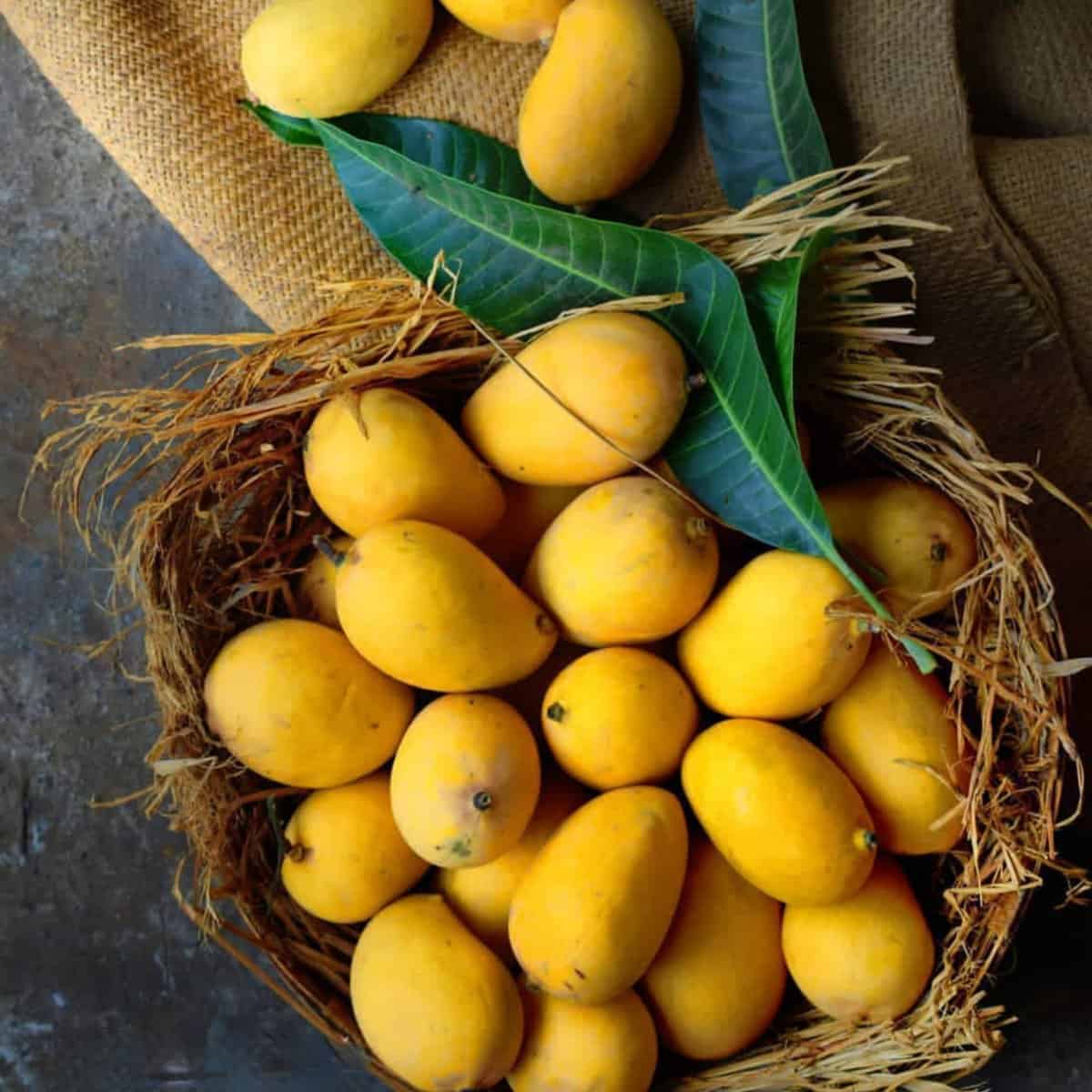Mangoes: Everything You Need to Know About Types, Storage & Nutrition
Mangoes are delicious and nutritious, but how much do you know about them?
Mangoes are a delicious fruit from the “mango” tree. They’re native to India and Southeast Asia, but are grown in many tropical and subtropical countries worldwide. The fruit is yellow when ripe and has a soft, sweet, edible flesh.
Mangoes are a great source of vitamins C and A, and contain fiber and antioxidants. They’re also low in calories and high in potassium. In this guide, I’ll tell you everything you need to know about mangoes.


Check out our new cookbook
Bitemybun's family recipes with complete meal planner and recipe guide.
Try it out for free with Kindle Unlimited:
Read for freeIn this post we'll cover:
Let’s Talk Mango: The King of Fruits
Mangoes are a stone fruit that are produced from the mango tree, scientifically known as Mangifera indica. It is believed that mangoes originated in the northwestern regions of India and northeastern regions of Myanmar. Mangoes come in various sizes and colors, ranging from small to large and green to yellow. The flesh of the fruit is typically sweet and edible, surrounding a hard pit or stone that is not edible. The skin of the fruit ranges from green to soft yellow and is typically peeled before consumption.
Popular Countries and Varieties
Mangoes are a tropical fruit and are grown in many countries, including Mexico, India, Thailand, and the Philippines. There are over 500 varieties of mangoes, each with its own unique taste and texture. Some of the most popular varieties include:
- Alphonso: a sweet and fragrant mango from India
- Ataulfo: a small and sweet mango from Mexico
- Tommy Atkins: a large and firm mango from Florida
Uses and Recipes
Mangoes are a versatile fruit that can be used in both sweet and savory dishes. Here are some ways to enjoy mangoes:
- Cut up a fresh mango and enjoy it as a sweet snack or dessert.
- Use mango in smoothies or juices for a tropical twist.
- Combine mango with other fruits in a fruit salad.
- Use mango in recipes for savory dishes, such as mango salsa or mango chicken.
- Enjoy dried mango as a snack.
Raw vs. Cooked Mango
Mangoes can be enjoyed raw or cooked. When raw, mangoes are typically moderately firm and slightly sour. When cooked, mangoes become softer and sweeter. Unripe mangoes are often used in savory dishes, while ripe mangoes are used in sweet dishes.
Discover the Mango World: A Guide to Different Types of Mangoes
Mangoes come in a variety of shapes, sizes, and colors. Here are some of the most commonly found types of mangoes in the United States:
- Haden: This is the most popular mango variety in the country. It is large, sweet, and has a bright red and green skin.
- Tommy Atkins: This type of mango is widely available and is known for its firm flesh and slightly tart taste. It has a dark red and green skin.
- Keitt: This mango is usually found later in the year and is known for its long oval shape and green skin. It has a sweet and juicy flesh.
The Unique and Exotic Mango Types
If you’re looking for something new and different, try these unique mango varieties:
- Alphonso: This mango is considered the king of mangoes and is widely produced in India. It has a rich, sweet flavor and a bright yellow flesh.
- Chaunsa: This type of mango is known for its excellent texture and sweet pulp. It has a bright yellow skin with a red blush.
- Dasheri: This mango is a popular variety in South Asia and has a unique texture that is both solid and smooth. It has a bright yellow skin with a red blush.
The Lesser-Known Mango Types
If you’re dedicated to trying every type of mango out there, check out these lesser-known varieties:
- Ataulfo: This mango is also known as the honey mango and is small and yellow. It has a sweet and creamy texture and is commonly found in Mexico.
- Francis: This mango is grown in Haiti and is known for its high-quality flesh and sweet flavor. It has a green and yellow skin with a red blush.
- Kesar: This mango is grown in the state of Gujarat in India and is known for its bright orange flesh and sweet flavor. It has a small size and a unique aroma.
The Best Mangoes for Different Uses
Depending on what you’re using your mangoes for, you may want to choose a specific type:
- For making mango salsa or chutney, choose a mango with a firm texture like the Tommy Atkins.
- For eating fresh, choose a mango with a sweet and juicy flesh like the Haden or Alphonso.
- For making smoothies, choose a mango with a smooth texture like the Dasheri.
The History and Origin of Mangoes
Mangoes originated in India over 5,000 years ago and were considered a symbol of love and friendship. They were brought to other parts of the world by traders and explorers, and are now grown in many countries including the United States. The main mango-producing states in the US are Florida and California.
The Different Stages of Mango Ripeness
Mangoes go through different stages of ripeness, each with its own unique characteristics:
- Green: At this stage, mangoes are firm and not yet ripe. They are commonly used in cooking and pickling.
- Turning: Mangoes at this stage are starting to change color and become slightly softer. They are perfect for making mango salsa or chutney.
- Ripe: Ripe mangoes are sweet and juicy with a soft texture. They are perfect for eating fresh or making smoothies.
- Overripe: Mangoes that are overripe are soft and may have brown spots. They are still edible but are best used for making jams or sauces.
The Health Benefits of Mangoes
Mangoes are not only delicious but also incredibly nutritious. They are high in vitamin C, vitamin A, and fiber. They also contain antioxidants that can help protect against cancer and other diseases. Mangoes are a great addition to any healthy diet.
Keeping Your Mangoes Fresh and Delicious: Proper Storage Techniques
When it comes to storing mangoes, it’s important to know the stage of ripeness they’re in. Mangoes can be stored at different stages, depending on when you plan to eat them. Here are some tips:
- Unripe mangoes can be stored at room temperature until they’re ready to eat. They’ll continue to ripen and get sweeter and softer over time.
- Ripe mangoes should be eaten as soon as possible, but if you can’t eat them right away, store them in the fridge to slow down the ripening process.
Choosing the Right Place to Store Mangoes
Where you store your mangoes can make a big difference in how long they last and how delicious they taste. Here are some tips:
- Store mangoes in a cool, dry place away from direct sunlight.
- If you’re storing ripe mangoes, keep them in the fridge to slow down the ripening process.
- If you’re storing unripe mangoes, keep them at room temperature to speed up the ripening process.
Using Proper Storage Containers
The right storage container can help keep your mangoes fresh and delicious. Here are some tips:
- Store mangoes in a paper bag to speed up the ripening process.
- Store ripe mangoes in a plastic bag or airtight container in the fridge to keep them fresh for longer.
- Avoid storing mangoes in jars or containers with limited airflow, as this can cause them to release an odorless gas that speeds up the ripening process.
Additional Tips for Storing Mangoes
Here are some additional tips to help you store your mangoes properly:
- Don’t store mangoes near other fruits, as they can cause each other to ripen faster.
- If you’re storing diced mangoes, keep them in an airtight container in the fridge for up to three days.
- Mangoes can be baked or added to your morning oatmeal for a delicious addition to your breakfast.
- March is peak mango season, so take advantage of the abundance of fresh mangoes and store them properly to enjoy them all year round.
Unlocking the Nutritional Benefits of Mangoes
Mangoes are not only good in size and taste, but they also offer multiple benefits to the body. This tropical fruit is rich in essential vitamins, minerals, and nutrients that can contribute to a healthy diet. Here’s some additional information on the nutritional value of mangoes:
- One cup (165 g) of fresh mango provides:
– Calories: 99
– Carbohydrates: 24.7 g
– Fiber: 2.6 g
– Sugar: 22.5 g
– Protein: 1.4 g
– Fat: 0.6 g
- Mangoes contain critical ingredients that are essential for the body, including vitamin C, vitamin A, folate, iron, and calcium.
- Depending on the type of mango, the material inside the stone may be edible and provide additional nutrients.
- Mangoes are generally low in calories and have a low glycemic index, making them a healthy food option.
Mango Nutrition for Specific Needs
- For pregnant women: Mangoes are a good source of folate, which is critical for preventing birth defects. However, pregnant women should avoid consuming unripe mangoes as they can cause contractions.
- For people with diabetes: While mangoes do contain carbohydrates and sugar, they also have a low glycemic index and load, making them a possible food option for people with diabetes. However, it’s important to note that consuming too many mangoes can still raise blood sugar levels.
- For people with specific nutrient requirements: Mangoes are rich in vitamins and minerals like vitamin C, vitamin A, and iron, making them a great addition to a dietary plan that requires these nutrients.
How to Consume Mangoes for Optimal Nutrition
- Eat fresh mangoes: Raw mangoes provide the highest nutritional value.
- Use mangoes as a healthy snack: One serving of mango (1 cup) provides about 100% of the daily requirement of vitamin C and 35% of the daily requirement of vitamin A.
- Add mangoes to smoothies or salads: Mangoes can be a great addition to a variety of dishes and can contribute to a healthy diet.
In conclusion, mangoes are a healthy and delicious tropical fruit that can provide numerous nutritional benefits to the body. By incorporating mangoes into your diet, you can contribute to the health of your cells, tissues, and DNA. So, next time you come across a mango, don’t hesitate to consume it and enjoy its rich comp of vitamins, minerals, and nutrients.
Conclusion
Mangoes are a delicious tropical fruit with a sweet flavor and a soft texture. They’re perfect for eating fresh, used in savory dishes, or made into smoothies. Mangoes are a great way to add some sunshine to your day!
Check out our new cookbook
Bitemybun's family recipes with complete meal planner and recipe guide.
Try it out for free with Kindle Unlimited:
Read for freeJoost Nusselder, the founder of Bite My Bun is a content marketer, dad and loves trying out new food with Japanese food at the heart of his passion, and together with his team he's been creating in-depth blog articles since 2016 to help loyal readers with recipes and cooking tips.
